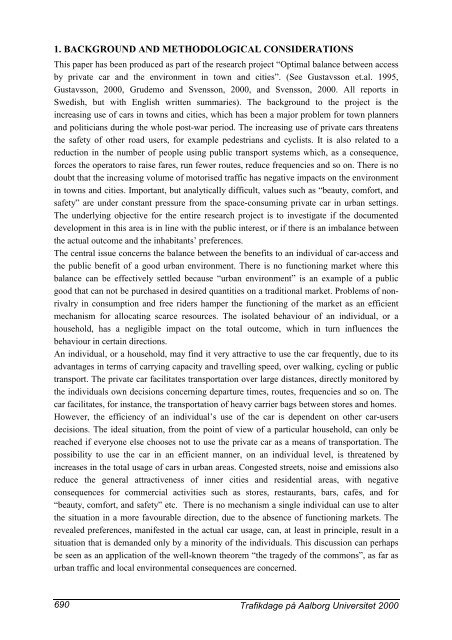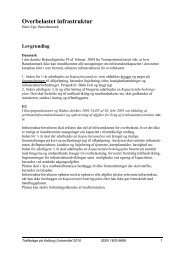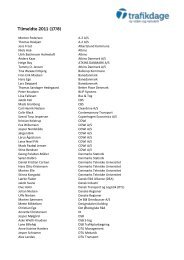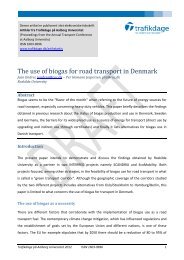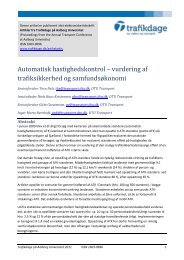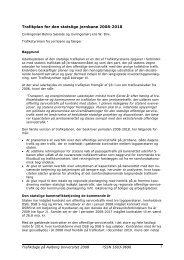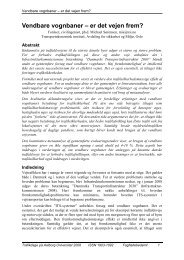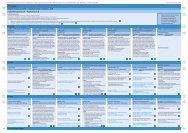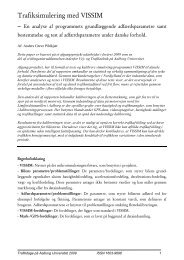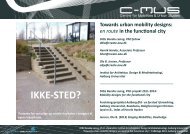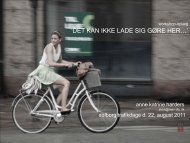Hent paperet som PDF-fil - Trafikdage.dk
Hent paperet som PDF-fil - Trafikdage.dk
Hent paperet som PDF-fil - Trafikdage.dk
You also want an ePaper? Increase the reach of your titles
YUMPU automatically turns print PDFs into web optimized ePapers that Google loves.
1. BACKGROUND AND METHODOLOGICAL CONSIDERATIONS<br />
This paper has been produced as part of the research project “Optimal balance between access<br />
by private car and the environment in town and cities”. (See Gustavsson et.al. 1995,<br />
Gustavsson, 2000, Grudemo and Svensson, 2000, and Svensson, 2000. All reports in<br />
Swedish, but with English written summaries). The background to the project is the<br />
increasing use of cars in towns and cities, which has been a major problem for town planners<br />
and politicians during the whole post-war period. The increasing use of private cars threatens<br />
the safety of other road users, for example pedestrians and cyclists. It is also related to a<br />
reduction in the number of people using public transport systems which, as a consequence,<br />
forces the operators to raise fares, run fewer routes, reduce frequencies and so on. There is no<br />
doubt that the increasing volume of motorised traffic has negative impacts on the environment<br />
in towns and cities. Important, but analytically difficult, values such as “beauty, comfort, and<br />
safety” are under constant pressure from the space-consuming private car in urban settings.<br />
The underlying objective for the entire research project is to investigate if the documented<br />
development in this area is in line with the public interest, or if there is an imbalance between<br />
the actual outcome and the inhabitants’ preferences.<br />
The central issue concerns the balance between the benefits to an individual of car-access and<br />
the public benefit of a good urban environment. There is no functioning market where this<br />
balance can be effectively settled because “urban environment” is an example of a public<br />
good that can not be purchased in desired quantities on a traditional market. Problems of nonrivalry<br />
in consumption and free riders hamper the functioning of the market as an efficient<br />
mechanism for allocating scarce resources. The isolated behaviour of an individual, or a<br />
household, has a negligible impact on the total outcome, which in turn influences the<br />
behaviour in certain directions.<br />
An individual, or a household, may find it very attractive to use the car frequently, due to its<br />
advantages in terms of carrying capacity and travelling speed, over walking, cycling or public<br />
transport. The private car facilitates transportation over large distances, directly monitored by<br />
the individuals own decisions concerning departure times, routes, frequencies and so on. The<br />
car facilitates, for instance, the transportation of heavy carrier bags between stores and homes.<br />
However, the efficiency of an individual’s use of the car is dependent on other car-users<br />
decisions. The ideal situation, from the point of view of a particular household, can only be<br />
reached if everyone else chooses not to use the private car as a means of transportation. The<br />
possibility to use the car in an efficient manner, on an individual level, is threatened by<br />
increases in the total usage of cars in urban areas. Congested streets, noise and emissions also<br />
reduce the general attractiveness of inner cities and residential areas, with negative<br />
consequences for commercial activities such as stores, restaurants, bars, cafés, and for<br />
“beauty, comfort, and safety” etc. There is no mechanism a single individual can use to alter<br />
the situation in a more favourable direction, due to the absence of functioning markets. The<br />
revealed preferences, manifested in the actual car usage, can, at least in principle, result in a<br />
situation that is demanded only by a minority of the individuals. This discussion can perhaps<br />
be seen as an application of the well-known theorem “the tragedy of the commons”, as far as<br />
urban traffic and local environmental consequences are concerned.<br />
690<br />
<strong>Trafikdage</strong> på Aalborg Universitet 2000


